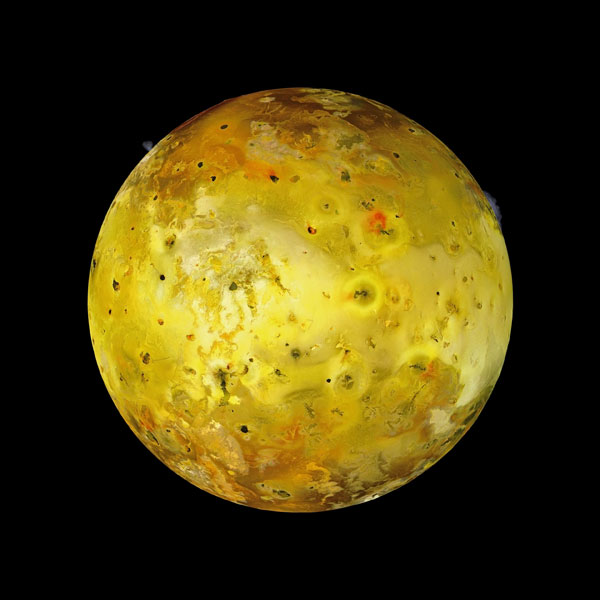“An animation of three near-infrared images of Uranus captured by the JWST Space Telescope with assigned representative colors. During processing, I aligned the rings separately to reduce the bubbling effect caused by different inclinations, making the planet appear to rotate on an almost flat plane.” —Andrea Luck
URANUS FROM THE JAMES WEBB SPACE TELESCOPE
This is not natural light, nothing is from Webb. The infrared image combines data from two filters which are shown in blue and orange,. The planet displays a blue hue in the resulting representative-color image which is similar to the planet’s actual color. But in reality Uranus is more a pale blue/green.
This is only the third facility to ever image the rings of Uranus: Voyager 2 spacecraft in 1986; and the Keck Observatory with advanced adaptive optics.
Cyber Tuesday Spaceprobe Deal
 For two days only, buy one of our limited edition Robotic Spacecraft Series Prints and get the full suite of vinyl stickers for free. This is a total savings of $24 and would serve as a great stocking stuffer to follow the presentation of the print.
For two days only, buy one of our limited edition Robotic Spacecraft Series Prints and get the full suite of vinyl stickers for free. This is a total savings of $24 and would serve as a great stocking stuffer to follow the presentation of the print.
Historic Robotic Spacecraft Poster Survey
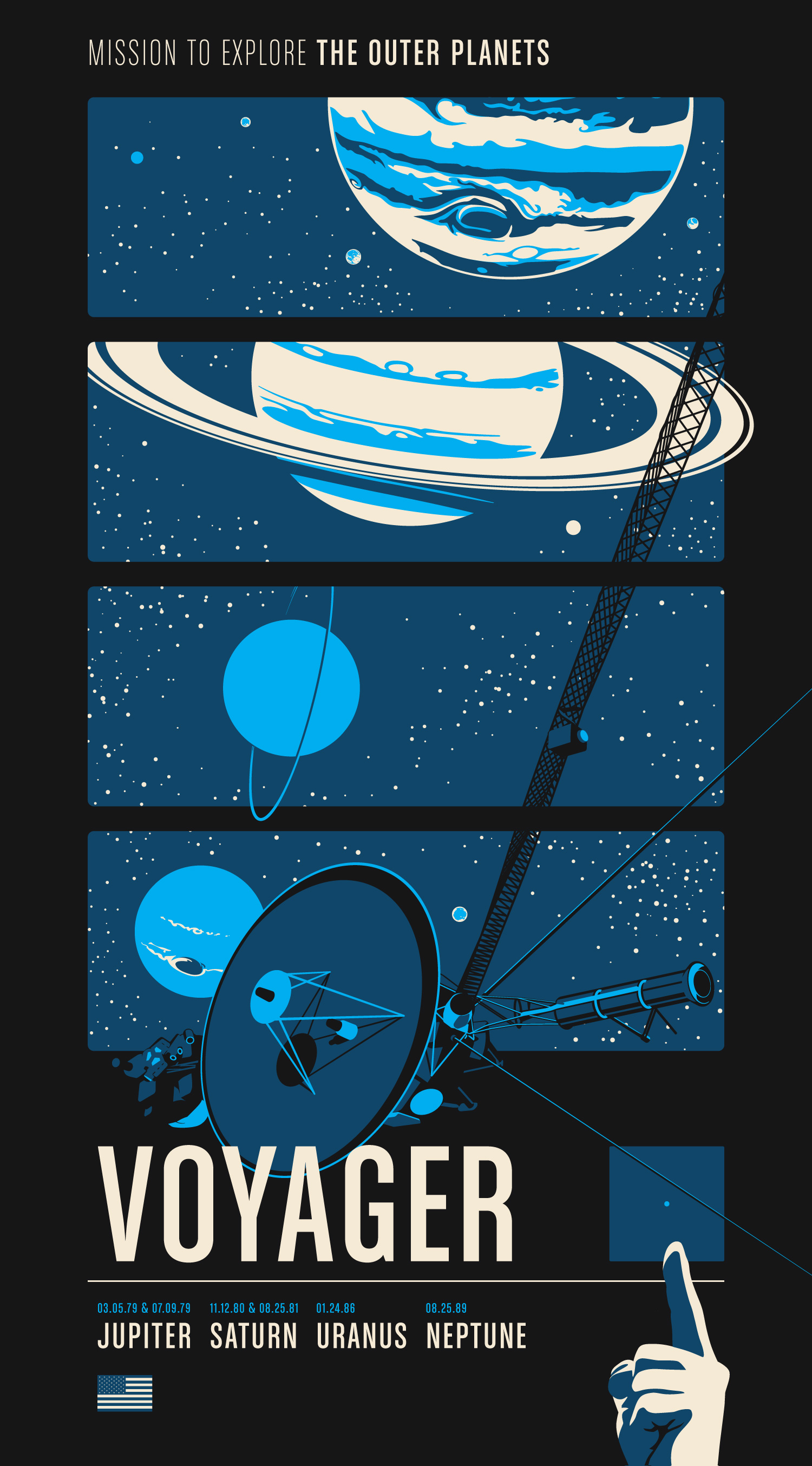 Our new Kickstarter project proposes the creation of three screen-printed posters celebrating the most popular and notable interplanetary robotic space missions in history. Going into this, we knew that poster #1 had to go to the hugely popular Voyager missions (shown above). However, we need your help selecting the themes of posters #2 and #3. So head over to The Planetary Society now to vote on your three favorite missions, but do it by the 19th to have it count for the poster selection. If this goes better than expected we could even wind up designing a fourth or fifth.
Our new Kickstarter project proposes the creation of three screen-printed posters celebrating the most popular and notable interplanetary robotic space missions in history. Going into this, we knew that poster #1 had to go to the hugely popular Voyager missions (shown above). However, we need your help selecting the themes of posters #2 and #3. So head over to The Planetary Society now to vote on your three favorite missions, but do it by the 19th to have it count for the poster selection. If this goes better than expected we could even wind up designing a fourth or fifth.
Check Out Kurzgesagt
Especially if you have kids with an appreciation for science. These guys regularly do great animations that explain complex science — appropriate for all ages. They also promise a series of cool videos about cool moons in our solar system. So far they have only covered our own, next up… Mars’ Deimos and Phobos.
Uranus as Seen from Saturn
 Pretty cool detail caught by two imagers whose work I have been noticing more and more of late. That small blue dot is not Earth, but it is Uranus as it appears from Saturn orbit. Reminds me of this post of our own moon seen with other heavenly bodies within the same frame.
Pretty cool detail caught by two imagers whose work I have been noticing more and more of late. That small blue dot is not Earth, but it is Uranus as it appears from Saturn orbit. Reminds me of this post of our own moon seen with other heavenly bodies within the same frame.
Taken by Cassini on April 11, 2014 and processed by Ian Regan with montage by Val Klavans.
Planetfall
Having followed the activities of a small army of freelance space imagers that lurk in various places on the internet for about 10 years now — it is truly unusual for me to come across images that I know I have not seen before. Michael Benson’s exhibit titled, “Planetfall” at the American Association for the Advancement of Science offers offer fresh views from missions as old as Viking and as new as Cassini. What originally caught my attention was an image of an actively spewing Enceladus that is exposed in both Sun and Saturn shine — a view I have surely seen before, but never so detailed or dramatic. Even more surprising and rare is a new global composite view of Uranus with a complete and continuous ring taken by Voyager almost 30 years ago.
The show ends soon (June 28, 2013) and is located in Washington DC.
You Are the Center of the Solar System
 You Are The Sun is the latest space themed tee by Chop Shop Store. Following on iconic tees that collected various deep space missions and historic Earth orbit missions, this new design draws a new picture of The Solar System as we know it today, complete with Carl Sagan’s pale blue dot.
You Are The Sun is the latest space themed tee by Chop Shop Store. Following on iconic tees that collected various deep space missions and historic Earth orbit missions, this new design draws a new picture of The Solar System as we know it today, complete with Carl Sagan’s pale blue dot.

With your head as a stand-in for The Sun — the tee includes all 8 planets, 7 major moons, The Asteroid Belt and even details little Pluto lost among countless Kuiper Belt objects. We are now providing yet another link here to get it for Men on American Apparel 2001 or Tultex tees and for Women on American Apparel 2102 tees.
Umbriel, Moon of Uranus
 A view of Umbriel from Voyager 2 in 1986. Thanks to Ted Stryk who specializes in re-imaging images from old missions with today’s advanced computing. There are few images of this place and no missions planned any time soon… so these may be all we ever see of it in our lifetime.
A view of Umbriel from Voyager 2 in 1986. Thanks to Ted Stryk who specializes in re-imaging images from old missions with today’s advanced computing. There are few images of this place and no missions planned any time soon… so these may be all we ever see of it in our lifetime.
The most interesting detail revealed in these images is the bright white disk that appears at the top of this image which is actually at the equator. Since the Uranian system is turned on its side almost 90 degrees to the rest of the solar system, Voyager passed all of its moons at nearly the same time. The orientation means we are actually seeing the southern pole nearly straight on in both these images. Such an unusually high-contrast feature reminds one of Saturn’s strange moon Iapetus. It could be the same phenomenon that made Iapetus look the way it does may have also been at work on Umbriel.
50 Years of Space Exploration Map
 This is so nice, but I am furious that I didn’t get to design this. This is Information design at it’s best naturally by National Geographic. You can see 50 years of robotic planetary exploration at a glance. It even includes failed missions represented by darker desaturated lines. As far as I can tell the cream colored lines are US and the red ones are Soviet. Interesting to see how many of those lines go dark around Mars.
This is so nice, but I am furious that I didn’t get to design this. This is Information design at it’s best naturally by National Geographic. You can see 50 years of robotic planetary exploration at a glance. It even includes failed missions represented by darker desaturated lines. As far as I can tell the cream colored lines are US and the red ones are Soviet. Interesting to see how many of those lines go dark around Mars.
Now where does one purchase such a thing? Perhaps this month’s issue of NG? Here is the link to it on their site complete with zoom viewer and them some kind samaritan posted a hires version to flickr.
iPhone Skins Featured on feulyourcreativity.com
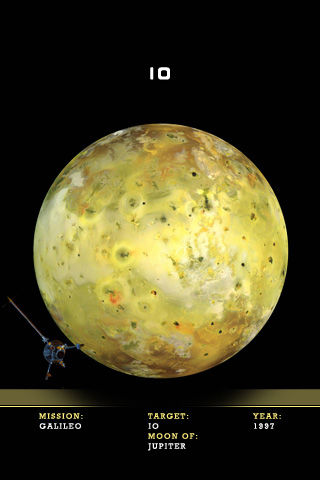 Not to re-post old material, but our iPhone planetary skins were recently posted to fuelyourcreativity.com for free download. So I thought I would just remind everyone and maybe direct a little traffic love their way.
Not to re-post old material, but our iPhone planetary skins were recently posted to fuelyourcreativity.com for free download. So I thought I would just remind everyone and maybe direct a little traffic love their way.
Uranian Moons, I Hardly Know Ye
 Its not something we are likely to see again anytime soon, so it is especially nice of Ted to re-image these old voyager images. These are the definitive best shots of each of these bodies, with perhaps the exception of Miranda (second from left, note there is a tiny dark moon which is first). Of the Uranian family, Miranda also happens to be the most interesting (of what know) with its cracks and ridges that somewhat resemble those processes happening on Enceladus and Europa.
Its not something we are likely to see again anytime soon, so it is especially nice of Ted to re-image these old voyager images. These are the definitive best shots of each of these bodies, with perhaps the exception of Miranda (second from left, note there is a tiny dark moon which is first). Of the Uranian family, Miranda also happens to be the most interesting (of what know) with its cracks and ridges that somewhat resemble those processes happening on Enceladus and Europa.
The iPhone Set 01: Bodies of Major Interest
 If I am going to keep making these things… I’d be a fool to not include a set for the Apple iPhone. Coincidentally, when you purchase your iPhone and do not yet have a phone service, the phone displays a full-disc image of the Earth pretty much displayed exactly as these do when uploaded to your iPhone. So in the spirit of continuity, you can now opt instead to have Mercury, Venus, Earth, The Moon (Luna), Mars, Jupiter, Io, Europa, Ganymede, Callisto, Saturn, Enceladus, Titan, Iapetus, Hyperion, Uranus, Miranda, Neptune or Triton grace your screen instead of the default Earth.
If I am going to keep making these things… I’d be a fool to not include a set for the Apple iPhone. Coincidentally, when you purchase your iPhone and do not yet have a phone service, the phone displays a full-disc image of the Earth pretty much displayed exactly as these do when uploaded to your iPhone. So in the spirit of continuity, you can now opt instead to have Mercury, Venus, Earth, The Moon (Luna), Mars, Jupiter, Io, Europa, Ganymede, Callisto, Saturn, Enceladus, Titan, Iapetus, Hyperion, Uranus, Miranda, Neptune or Triton grace your screen instead of the default Earth.
The easiest way to install wallpapers to your iPhone is to make a special set in iPhoto and simply drag all the files to that folder. Then in iTunes have your iPhone sync that folder to your photos collection. After that it is as simple as opening the “Photos” area of your iPhone. Go to your new folder of images and open whichever image you want. Then tap on the image just once and assign it as a wallpaper using the “Use as Wallpaper” button in the lower left corner of the screen.
If you have a PC I have no idea in hell how the hell you get images into your iPhone. I would buy a Mac… you have an iPhone and use iTunes… you are half-way there.
For a version of these with no graphics see this link.
Wallpaper 2560x1600 Set 03: The Planets
The planets – the complete set for collectors! While there are literally thousands of images of the planets to choose from… full globe high resolution images are actually fairly rare. They usually require many exposures to be stitched together to make one large complete image. This is not only difficult to work out across the great distances of space, but also soaks up a large amount of valuable spacecraft time and energy. This set represents the best available images of each planet in our Solar System.
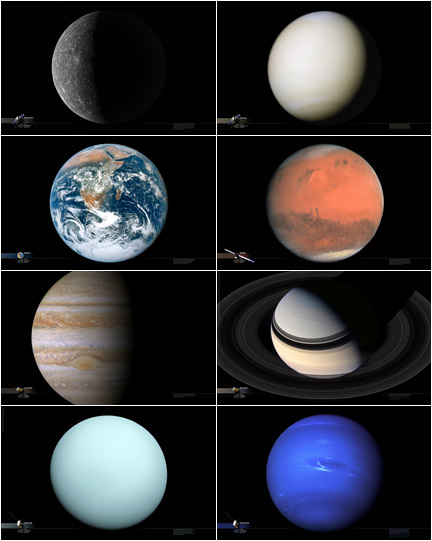
Sorry, no Pluto for more than one reason.
On Holiday
I am currently on holiday in Doolin, Ireland am not expecting to make any posts during the week. Upon return wanderingspace will be putting a full-time effort into the Carnival of Space (see previous post).
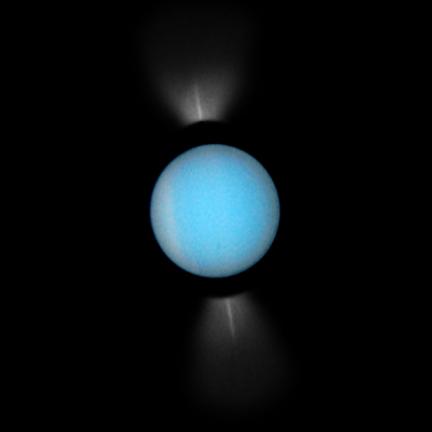 Until then, enjoy this rare occasion of Hubble’s view of Uranus as it’s rings are seen “edge on” for the first time in 42 years. Since the rings were only discovered in the late 70’s this would be the first time we have ever had the opportunity to view them this way.
Until then, enjoy this rare occasion of Hubble’s view of Uranus as it’s rings are seen “edge on” for the first time in 42 years. Since the rings were only discovered in the late 70’s this would be the first time we have ever had the opportunity to view them this way.
Wallpaper: Ariel Portrait
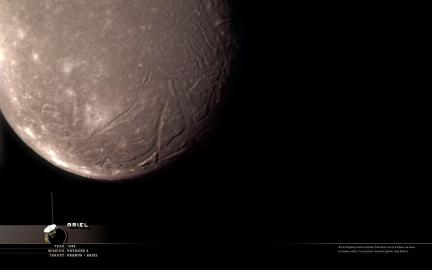 Ariel is the third of the five larger moons or Uranus. It is somewhat similar to Saturn’s Rhea in composition, about 30% rock and 70% ices. There are obvious ridges and details that would appear to be somewhat “young” features (which is still quite old to you and me), but there is little known about this moon as it was only viewed once from 127,000 km by Voyager 2.
Ariel is the third of the five larger moons or Uranus. It is somewhat similar to Saturn’s Rhea in composition, about 30% rock and 70% ices. There are obvious ridges and details that would appear to be somewhat “young” features (which is still quite old to you and me), but there is little known about this moon as it was only viewed once from 127,000 km by Voyager 2.
Wallpaper: Miranda Portrait
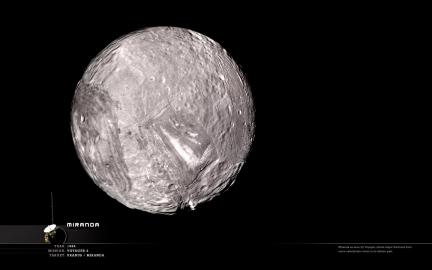 Of the five moons of Uranus, the only one to really stand out would be Miranda. One look at the moon suggests that some kind of cataclysmic event must have taken place in its past - huge fault canyons and ridges run across its surface. However, newer theories have replaced the idea that Miranda was shattered several times and instead suggest that somehow internal heating has caused lighter materials to rise up in various locations to the surface. Internal heating in smaller objects (Miranda is about 470km wide) is no longer an unexpected thing in the outer solar system. If it is ever confirmed that Miranda does in fact experience internal heating it will join Enceladus, Io and Europa (and possibly others) in this whole new class of body to be explored in the Solar System.
Of the five moons of Uranus, the only one to really stand out would be Miranda. One look at the moon suggests that some kind of cataclysmic event must have taken place in its past - huge fault canyons and ridges run across its surface. However, newer theories have replaced the idea that Miranda was shattered several times and instead suggest that somehow internal heating has caused lighter materials to rise up in various locations to the surface. Internal heating in smaller objects (Miranda is about 470km wide) is no longer an unexpected thing in the outer solar system. If it is ever confirmed that Miranda does in fact experience internal heating it will join Enceladus, Io and Europa (and possibly others) in this whole new class of body to be explored in the Solar System.
Wallpaper: Uranus Portrait
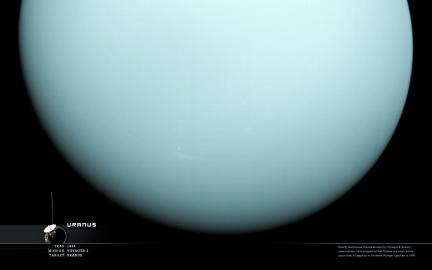 Second only to Mercury, Uranus tends to get the “boring” award from most due to its lack of almost any kind of cloud details. Among its five moons, there also isn’t really that much going on beyond what one might expect from such medium to small sized moons (with the possible exception of Miranda). However, there are a few things about Uranus that strike interest in it like the ring system, its axis is turned to about 98 degrees and more recently Hubble observations suggest that Uranus does have periodic cloud details not seen when Voyager flew past. As fate would have it, Uranus was in an unusually quiet mood in 1986.
Second only to Mercury, Uranus tends to get the “boring” award from most due to its lack of almost any kind of cloud details. Among its five moons, there also isn’t really that much going on beyond what one might expect from such medium to small sized moons (with the possible exception of Miranda). However, there are a few things about Uranus that strike interest in it like the ring system, its axis is turned to about 98 degrees and more recently Hubble observations suggest that Uranus does have periodic cloud details not seen when Voyager flew past. As fate would have it, Uranus was in an unusually quiet mood in 1986.


